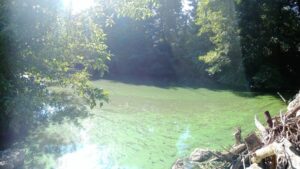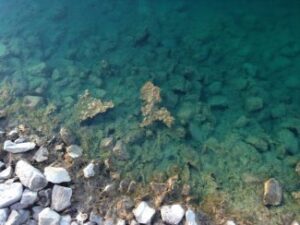
Blue-green algae toxins are deadly. An animal that drinks contaminated water dies in less than 24 hours.
Ranchers typically find the dead animal beside a contaminated stock dam, explained SDSU Extension Cow/Calf Field Specialist Robin Salverson. However, by the time the cause of death is determined, the blue-green algae toxins may have dissipated. “It can come and go so quickly in some cases, but in others, it (harmful algal blooms) can be more persistent.”
Warm weather, calm condition, sunlight and ample nutrients—nitrates and phosphorus—in the water create ideal conditions for algal blooms, which typically occur in late summer and early fall. However, “the variation can be baffling,” noted Salverson, pointing to an instance in which “algal blooms affected water in pasture with no fields for miles.”
That’s why South Dakota State University faculty researchers from the South Dakota Water Resources Institute and SDSU Extension are part of the North Central Region Water Network project that seeks to educate the public and promote research about harmful algal blooms, or HABs. The project brings together faculty from the state water resources research centers and cooperative extension offices at the Northern Central Region’s land grant institutions. U.S. Geological Survey is also a partner on the HAB project.
The resources that the Algal Bloom Action team is developing will be useful tools to educate South Dakotans about harmful algal blooms, according to SDSU Extension Water Resources Field Specialist David Kringen. He is the SDSU representative for the project, serving on the subcommittee developing written documents, such as fact sheets.
“Many states are dealing with harmful algal blooms and we can tackle these issues much better together than we can individually,” Kringen said.
Pooling resources
During the October 2020 Eastern South Dakota Water Conference, Amy Weckle, Illinois Water Resource Center program manager, and Hanna Bates, acting assistant director of the Iowa Water Center, described the HABs project, which began in 2018. After taking an inventory of the available literature, the team identified gaps in Extension and outreach as well as research recommendations for the region.

Some species of algae form long chains, clinging to rocks and sediment in ponds. (Photo courtesy of Frank Gibbs)
The team subdivided the project into five areas: general knowledge about HABs; identifying, monitoring and treating HABs; human health and HABs; animal health and HABs; and landscape nutrient management. The community engagement and outreach materials will be designed for many audiences—municipalities, lakefront property owners, rural and urban residents and farmers, as well as federal and state agencies, municipalities and the private sector.
Furthermore, the HABs team identified Extension as “a change agent that can bring this information to audiences to empower these communities,” Bates said.
Kringen said, “As outreach material is developed by the HABs team, we will let people know where the information is available.”
Advancing research
Strengthening HABs research is also one of the North Central Region Water Network’s goals. An inventory of water resources research center-funded research in the North Central Region showed that between 2014 and 2017, 30 projects related to HABS received more than $2 million in federal and matching funds. Fifteen of those projects focused on prediction and source detection. Only two were about animal health.
In January, the HABs team, now known as the Algal Bloom Action Team (ABAT) hosted its first annual research symposium and, in March, a series of six every-other-month webinars will begin. More information on HABs events will be posted at https://northcentralwater.org/habs/.
Social media and public service announcements will provide information to specific audiences and the team is preparing short videos as teaching tools. “We will update these outreach materials as the research becomes available,” Bates said.
In her role advising South Dakota producers, Salverson emphasized the need to “bring everyone up to speed on this area and what can be done to help manage it.” However, she noted, when it comes to mitigation and control, “based on my understanding of managing blue green algae in dams, what we can do is pretty limited and is not always effective. More research in this area would be beneficial.”
Because you cannot tell whether toxins are present just by the presence of algae, Kringen’s advice is simple: “If you see algae, be it red, green, blue or pink, keep pets, livestock and people away from the water.”
Article by: Christie Delfanian, South Dakota State University